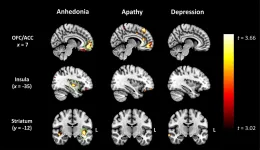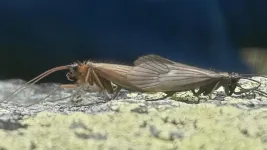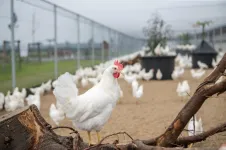A multidimensional view of the coronavirus
Covid-19: analysis of protein interactions as a route to new drugs
2021-04-12
(Press-News.org) What exactly happens when the corona virus SARS-CoV-2 infects a cell? In an article published in Nature, a team from the Technical University of Munich (TUM) and the Max Planck Institute of Biochemistry paints a comprehensive picture of the viral infection process. For the first time, the interaction between the coronavirus and a cell is documented at five distinct proteomics levels during viral infection. This knowledge will help to gain a better understanding of the virus and find potential starting points for therapies.
When a virus enters a cell, viral and cellular protein molecules begin to interact. Both the replication of the virus and the reaction of the cells are the result of complex protein signaling cascades. A team led by Andreas Pichlmair, Professor of Immunopathology of Viral Infections at the Institute of Virology at TUM, and Matthias Mann, Head of the Department of Proteomics and Signal Transduction at the Max Planck Institute of Biochemistry, has systematically recorded how human lung cells react to individual proteins of the covid-19 pathogen SARS-CoV-2 and the SARS coronavirus, the latter of which has been known for some time.
A detailed interaction map
To this end, more than 1200 samples were analyzed using the state-of-the-art mass spectrometry techniques and advanced bioinformatic methods. The result is a freely accessible dataset that provides information on which cellular proteins the viral proteins bind to and the effects of these interactions on the cell. In total, 1484 interactions between viral proteins and human cellular proteins were discovered. "Had we only looked at proteins, however, we would have missed out on important information", says Andreas Pichlmair. "A database that only includes the proteome would be like a map containing just the place names but no roads or rivers. If you knew about the connections between the points on that map, you could gain much more useful information."
According to Pichlmair, important counterparts to the network of traffic routes on a map are protein modifications called phosphorylation and ubiquitination. Both are processes in which other molecules are attached to proteins, thereby altering their functions. In a listing of proteins, these changes are not measured, so that there is no way of knowing whether proteins are active or inactive, for example. "Through our investigations, we systematically assign functions to the individual components of the pathogen, in addition to the cellular molecules that are switched off by the virus," explains Pichlmair. "There has been no comparable mapping for SARS-CoV-2 so far," adds Matthias Mann. "In a sense, we have taken a close look at five dimensions of the virus during an infection: its own active proteins and its effects on the host proteome, ubiquitinome, phosphoproteome and transcriptome."
Insights into how the virus works
Among other things, the database can also serve as a tool to find new drugs. By analyzing protein interactions and modifications, vulnerability hotspots of SARS-CoV-2 can be identified. These proteins bind to particularly important partners in cells and could serve as potential starting points for therapies. For example, the scientists concluded that certain compounds would inhibit the growth of SARS-CoV-2. Among them were some whose antiviral function is known, but also some compounds which have not yet been studied for efficacy against SARS-CoV-2. Further studies are needed to determine whether they show efficacy in clinical use against Covid-19.
"Currently, we are working on new anti Covid-19 drug candidates, that we have been able to identify through our analyses," says Andreas Pichlmair. "We are also developing a scoring system for automated identification of hotspots. I am convinced that detailed data sets and advanced analysis methods will enable us to develop effective drugs in a more targeted manner in the future and limit side effects in advance."
INFORMATION:
Publication:
A. Stukalov, V. Girault, V. Grass, O. Karayel, V. Bergant, C. Urban, D. A. Haas, Y. Huang, L. Oubraham, A. Wang, M. S. Hamad, A. Piras, F. M. Hansen, M. C. Tanzer, I. Paron, L. Zinzula, T. Enghleitner, M. Reinecke, T. M. Lavacca, R. Ehmann, R. Wölfel, J. Jores, B. Kuster, U. Protzer, R. Rad, J. Ziebuhr, V. Thiel, P. Scaturro, M. Mann & A. Pichlmair: Multilevel proteomics reveals host perturbations by SARS-CoV-2 and SARS-CoV, Nature, April 2021. DOI: 10.1038/s41586-021-03493-4.
More information:
Covinet database:
https://covinet.innatelab.virologie.med.tum.de
Article in TUM's Faszination Forschung Magazine describing Professor Pichlmair's research (PDF, 2,2 MB)
https://portal.mytum.de/pressestelle/faszination-forschung/2020nr25/03_Faszination_Forschung_25_20_Pichlmair_VirenMassenspektrometer_englisch.pdf/download
Andreas Pichlmair holds a professorship funded by the German Center for Infection Research (DZIF). The current study was funded by the European Research Council (ERC) as well as the German Federal Ministry of Education and Research. The TUM University Foundation provided funding for the screening platform used for this study.
High-resolution images:
https://mediatum.ub.tum.de/1609219
Contact:
Prof. Dr. Andreas Pichlmair
Technical University of Munich
Institute of Virology
Tel: +49 89 4140-9270
andreas.pichlmair@tum.de
ELSE PRESS RELEASES FROM THIS DATE:
2021-04-12
PHILADELPHIA - Residents in majority-Black neighborhoods experience higher rates of severe pregnancy-related health problems than those living in predominantly-white areas, according to a new study of pregnancies at a Philadelphia-based health system, which was led by researchers in the Perelman School of Medicine at the University of Pennsylvania. The findings, published today in Obstetrics and Gynecology, suggest that neighborhood-level public health interventions may be necessary in order to lower the rates of severe maternal morbidity -- such as a heart attack, heart failure, eclampsia, or hysterectomy -- and mortality ...
2021-04-12
April 12, 2021 - For critically ill COVID-19 patients treated with extracorporeal membrane oxygenation (ECMO), the risk of death remains high - but is much lower than suggested by initial studies, according to a report published today by Annals of Surgery. The journal is published in the Lippincott portfolio by Wolters Kluwer.
The findings support the use of ECMO as "salvage therapy" for COVID-19 patients with acute respiratory distress syndrome (ARDS) or respiratory failure who do not improve with conventional mechanical ventilatory support, according to the new research by Ninh T. Nguyen, MD, Chair of the Department of Surgery, University ...
2021-04-12
New research by Yale Cancer Center shows patients with early-onset colorectal cancer, age 50 and younger, have a better survival rate than patients diagnosed with the disease later in life. The study was presented virtually today at the American Association of Cancer Research (AACR) annual meeting.
"Although small, we were surprised by our findings," said En Cheng, MD, MSPH, lead author of the study from Yale Cancer Center. "Past studies have shown younger colorectal patients, those under 50, were reported to experience worse survival compared with patients diagnosed at older ages. We hope this result can be inspiring for these ...
2021-04-12
In a new study led by Yale Cancer Center, researchers have advanced a tumor-targeting and cell penetrating antibody that can deliver payloads to stimulate an immune response to help treat melanoma. The study was presented today at the American Association of Cancer Research (AACR) virtual annual meeting.
"Most approaches rely on direct injection into tumors of ribonucleic acids (RNAs) or other molecules to boost the immune response, but this is not practical in the clinic, especially for patients with advanced cancer," said Peter M. Glazer, MD, PhD, Chair of the Department of Therapeutic Radiology ...
2021-04-12
New research from CU Cancer Center member Scott Cramer, PhD, and his colleagues could help in the treatment of men with certain aggressive types of prostate cancer.
Published this week in the journal Molecular Cancer Research, Cramer's study specifically looks at how the loss of two specific prostate tumor-suppressing genes -- MAP3K7 and CHD1 --increases androgen receptor signaling and makes the patient more resistant to the anti-androgen therapy that is typically administered to reduce testosterone levels in prostate cancer patients.
"Doctors don't normally stratify patients based on this subtype and say, 'We're going to have to treat these people differently,' but we think this should be considered before treating ...
2021-04-12
KEY POINTS:
- Loss of pleasure has been revealed as a key feature in early-onset dementia (FTD), in contrast to Alzheimer's disease.
- Scans showed grey matter deterioration in the so-called pleasure system of the brain.
- These regions were distinct from those implicated in depression or apathy - suggesting a possible treatment target.
People with early-onset dementia are often mistaken for having depression and now Australian research has discovered the cause: a profound loss of ability to experience pleasure - for example a delicious meal or beautiful sunset - related to degeneration of 'hedonic hotspots' in the brain where pleasure mechanisms are concentrated.
The University of Sydney-led ...
2021-04-12
While the new Coronavirus will, hopefully, be effectively controlled sooner rather than later, its latest namesake is here to stay - a small caddisfly endemic to a national park in Kosovo that is new to science.
Potamophylax coronavirus was collected near a stream in the Bjeshkët e Nemuna National Park in Kosovo by a team of scientists, led by Professor Halil Ibrahimi of the University of Prishtina. After molecular and morphological analyses, it was described as a caddisfly species, new to science in the open-access, peer-reviewed Biodiversity Data Journal.
Ironically, the study of this new insect was impacted by the same pandemic that inspired its scientific name. Although it was collected a few years ago, the new species was only described during the global pandemic, ...
2021-04-12
New research shows that people who experience big dips in blood sugar levels, several hours after eating, end up feeling hungrier and consuming hundreds more calories during the day than others.
A study published today in Nature Metabolism, from PREDICT, the largest ongoing nutritional research program in the world that looks at responses to food in real life settings, the research team from King's College London and health science company ZOE (including scientists from Harvard Medical School, Harvard T.H. Chan School of Public Health, Massachusetts General Hospital, the University of Nottingham, Leeds University, and Lund University ...
2021-04-12
Between 2018 and 2020, 1,4 million EU citizens signed the petition 'End the Cage Age', with the aim of ending cage housing for farm animals in Europe. In response to this citizens initiative, the European Parliament requested a study by Utrecht University researchers on the possibilities to end cage housing. On 13 April, the scientists will present their report 'End the Cage Age - Looking for Alternatives' to the European Parliament.
In the report, behavioural biologists, animal scientists, veterinarians and ethicists from Utrecht University's Faculty of Veterinary Medicine analysed the available scientific literature on alternatives to cage housing. "Our focus was on laying hens and pigs" says Bas Rodenburg, Professor of Animal Welfare at Utrecht University. "Because these ...
2021-04-12
Many women "risk" allowing natural grey hair to show in order to feel authentic, a new study shows.
Researchers from the University of Exeter surveyed women who chose not to dye their grey hair, and found a "conflict" between looking natural and being seen as competent.
Participants in the study - mostly from English-speaking countries - belonged to online groups whose members allow their natural grey hair to show, and the researchers noted "solidarity and sisterhood" among these women.
"We are all constrained by society's norms and expectations when it comes to appearance, but expectations are more rigorous for women - especially older women," said lead author Vanessa Cecil, of the University of Exeter.
"The 'old woman' is an undesirable character in Western societies, being seen ...
LAST 30 PRESS RELEASES:
[Press-News.org] A multidimensional view of the coronavirus
Covid-19: analysis of protein interactions as a route to new drugs




